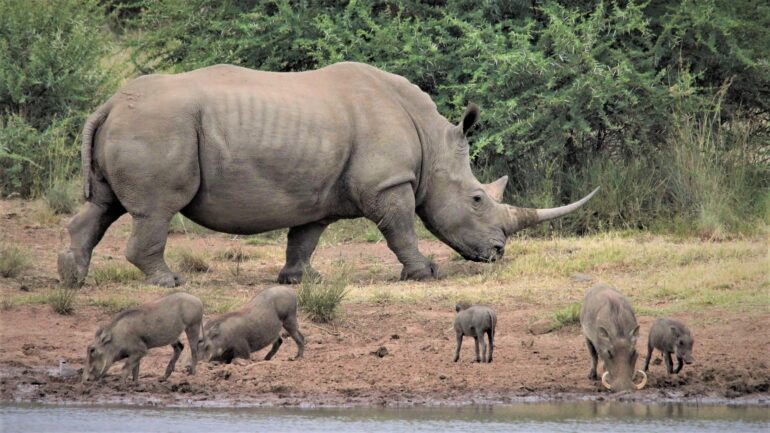TL;DR:
- African countries are intensifying conservation efforts to protect threatened wildlife due to climate change, poaching, and biodiversity loss.
- Botswana has established secure areas, such as the Khama Rhino Sanctuary, to safeguard rhino populations from poaching.
- Human-wildlife conflicts are being addressed through innovative strategies, including integrating indigenous dogs with livestock.
- Translocation initiatives are helping relocate species to counter overpopulation, poaching, and enhance genetic diversity.
- Drones and deep learning algorithms are transforming wildlife monitoring by offering noninvasive and accurate methods.
- Point pattern analysis enhances individual animal identification and population counts in monitoring efforts.
- Collaboration among stakeholders is crucial for successful conservation, extending beyond private entities.
Main AI News:
In the face of climate change, illegal poaching, and the alarming loss of biodiversity, several African nations have taken significant strides to bolster their conservation endeavors. These initiatives primarily target wildlife classified as near-threatened, vulnerable, endangered, or critically endangered, according to the International Union for Conservation of Nature (IUCN) Red List of Threatened Species. The ultimate aim? To safeguard the survival of Africa’s precious wildlife and restore equilibrium to its ecosystems.
Botswana’s Sanctuary Success Story
Botswana, for instance, has carved out safe havens like the Khama Rhino Sanctuary, dedicated to breeding near-threatened white rhinoceros (Ceratotherium simum) and the critically endangered black rhinoceros (Diceros bicornis). The poaching crisis, driven by the insatiable demand for rhino horns, necessitated such sanctuaries. Rigorous monitoring involves unique identification methods like ear-notching and the deployment of high-tech trackers, including GPS (global positioning system), to monitor these majestic creatures. Furthermore, constant military patrols fortify these sanctuaries, ensuring the utmost security.
Tackling Human-Wildlife Conflict
The encroachment of wildlife into human settlements often leads to human-wildlife conflicts, which can have devastating consequences. Predators like lions (Panthera leo), cheetahs (Acinonyx jubatus), and African wild dogs (Lycaon pictus) frequently prey on domesticated livestock, precipitating a decline in their populations. Organizations such as Cheetah Conservation Botswana and Communities Living Among Wildlife Sustainably Conservancy are committed to developing solutions that mitigate negative interactions and promote coexistence. An innovative approach involves integrating indigenous dogs with livestock as a strategy to protect threatened carnivores.
To address the issue of African elephants (Loxodonta africana) disrupting human settlements due to water scarcity, the Botswana government has initiated compensation measures for agricultural losses incurred because of wildlife incursions.
Translocation: A Vital Conservation Tool
Translocation plays a pivotal role in addressing overpopulation, poaching threats, and promoting genetic diversity. South Africa has been at the forefront of translocating rhinoceroses to other African countries. A study by Pfannerstill et al. revealed that relocating rhinoceroses from high-risk poaching areas in South Africa to the Okavango Delta in Botswana significantly boosted the local rhino population. Another success story unfolded in Mozambique, where rhinoceroses were reintroduced in August 2022 after a 40-year local extinction. Similarly, eight West African giraffes (Giraffa camelopardalis peralta) were translocated to the Gadabedji Biosphere Reserve, Niger, after nearly 50 years of absence due to drought and illegal poaching.
The Power of Technology: Drones and AI
The IUCN’s rigorous monitoring program for wildlife species can now harness the capabilities of drone technology. Drones, equipped with both visible light and thermal imaging cameras, offer a noninvasive approach to wildlife monitoring, avoiding the invasive techniques of ear-notching or attaching tracking devices. Affordable and accessible, drones are revolutionizing wildlife conservation in protected areas and community-based sanctuaries.
Deep Learning for Wildlife Monitoring
Deep learning algorithms have demonstrated promise in wildlife monitoring using images and videos from ground camera traps. Recent developments in automatic wildlife herd identification rely on the distinctive behavior of each herd, treating every animal as a unique data point. Despite challenges like natural camouflage and tree obstructions, this approach, known as point pattern analysis, enhances the accuracy of individual animal identification.
This innovative method shifts from direct animal counting to identifying herds based on observed behaviors and subsequently counting animals within the identified herd’s bounding box. This promises more reliable population counts, which is critical for effective conservation efforts.
A Collective Effort for Success
As drone technology and deep learning algorithms advance, they hold immense potential to revolutionize wildlife monitoring in ever-changing environments, contributing significantly to restoring ecological balance. Success, however, hinges on strong support from diverse stakeholders, including local communities, research scientists, law enforcement agencies, and government bodies, transcending the efforts of private entities alone. A united front is the key to Africa’s wildlife conservation success.
Conclusion:
The integration of drones and AI in African wildlife conservation represents a significant market opportunity. As technology advances and stakeholders collaborate, the demand for sophisticated monitoring solutions and the development of related services is likely to rise. Companies specializing in drone technology, deep learning algorithms, and conservation services stand to benefit from this growing market segment, provided they prioritize ethical and noninvasive wildlife monitoring practices.

